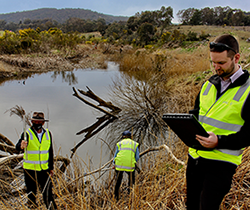Around the Regions
A train derailment in the west, a flood clean-up in the north, a clean waterways campaign in the south and odours management in the Hunter - we bring you news of initiatives and action from around our regions.

The EPA was on site as soon as a derailment and spill was reported near Parkes, Western NSW
EPA collaborates on western NSW derailment spill
When a Pacific National train derailed in July on the outskirts of Parkes in western NSW spilling 3000 litres of diesel, the EPA was called in.
EPA officers respond to emergency incidents that have the potential to impact the environment including truck crashes, spills and fires.
Fortunately, nobody was injured in the derailment. The accident was quickly reported to the EPA by Fire and Rescue NSW, who had stopped the leak and contained the spill to the immediate rail corridor.
While clean-up crews removed diesel from the train to prevent further spills and worked to right it, EPA officers were on-site to advise them on the containment and clean-up of the diesel, and to ensure there were no lasting impacts to the surrounding environment. This included imposing strict timeframes to clean the site before the next predicted rain, preventing spread of the diesel onto neighbouring farmland.
EPA officers also liaised with Parkes Shire Council to ensure the contaminated soil was removed for proper storage and treatment off-site.
All licensees are required to have Pollution Response Incident Management Plans in place that outline the steps of how they will respond in case of an emergency.
This is a good example of where a quick response resulted in the spill being contained and damage to the environment was minimised.
More information on How to Report incidents or Call the Environment Line on 131 555
Flood clean-up continues on the north coast

The EPA's post-flood clean-up on the Manning River was facilitated by expert contractors
The EPA continues to lead the collection and removal of flood debris from shorelines and waterways following the devastating floods earlier this year.
More than 3000m3 of waste has been collected to date with the clean-up spanning from the Hawkesbury River to the Queensland border.
EPA’s specialist marine clean-up contractor, Varley Group, removed flood debris from the Manning River on the Mid North Coast with the primary focus being the removal of 57 silage bales which had been washed off farmland and couldn’t be used. EPA staff were on-site to ensure impact to the environment was minimised while the work was being done.
A videographer was engaged by the EPA to film the clean-up. Watch video.
The footage was provided to the local television news to keep the local community informed on the work being done by the EPA.
The business of a drain is only for rain

EPA officers worked with local council to sample waterways in the Queanbeyan campaign
Queanbeyan industrial businesses have embraced a campaign to improve the health of their local waterways – home to important populations of platypus, Murray cod and native rakali (water rats).
The education campaign, which began at the start of this year urged businesses not to drain the health of local waterways by ensuring only rain went down the drain.
The EPA and Queanbeyan-Palerang Regional Council officers jointly visited 86 businesses to explain how industrial sites can help improve the quality of stormwater discharged to the Molonglo and Queanbeyan rivers.
The joint EPA-Council inspections explained best practice capture for any spills from chemical storage, the importance of dedicated washdown areas that don’t flow into stormwater drains and provided tips on how to stop the discharge of polluted runoff.
Other council areas interested in running a similar joint education campaign are welcome to contact the EPA on 131 555.
More information on the best practice stormwater management
Lake Macquarie waste facility fined for odours
The EPA has fined waste company Redmondis Australia at Awaba $8,000 for alleged offensive odours following the EPA receiving numerous complaints from residents and neighbours in April about a nauseating smell from the facility.
Attending EPA officers immediately detected strong putrid odours which were traced to a stockpile of composting material at the site. The officers identified that aerators used to dry out compost following intense rain were discharging putrid air, which was reaching neighbours nearby.
EPA Director Regulatory Operations Adam Gilligan said it was unacceptable for the community to be impacted by odours. “We don’t want to see residents unable to enjoy their homes and gardens,” Adam said.
Redmondis co-operated with the EPA investigation and made changes to the way operations are carried out at the facility, particularly following extreme wet weather.
Residents who experience odours are encouraged to make a report to the EPA’s 24-hour Environment Line on 131 555. More information about reporting odours

